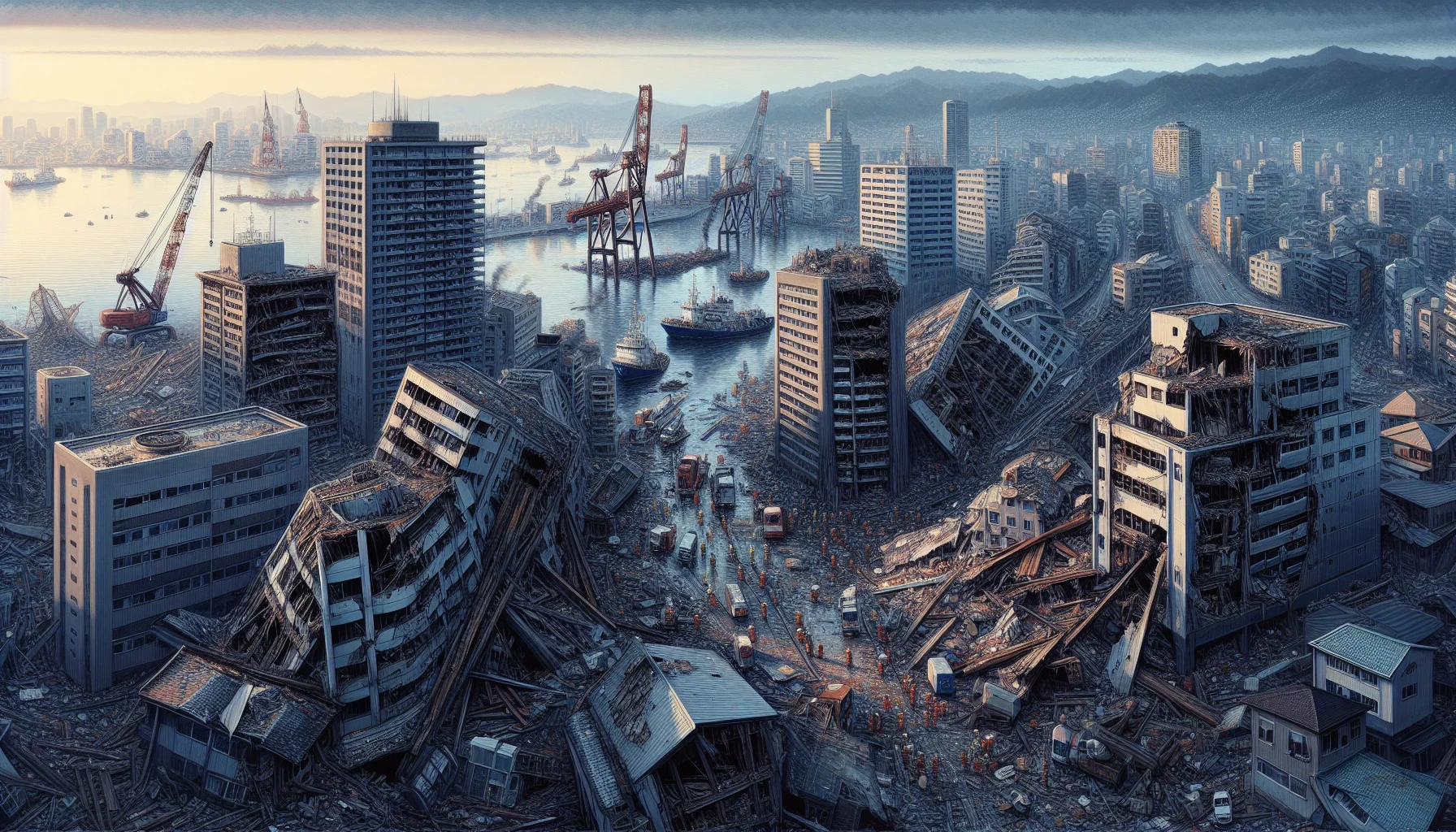
The Great Hanshin Earthquake
by: The Calamity Calendar Team
January 17, 1995
In the silent, early hours of January 17, 1995, as most of Kobe lay in slumber, the earth beneath this vibrant port city stirred violently, altering the landscape and lives of thousands forever. This catastrophic event, known as the Great Hanshin Earthquake, demonstrated not only the raw power of nature but also precipitated profound changes in Japan's approach to disaster preparedness.
The Setting: A City Ignorant of Its Fate
Kobe, a bustling port city on Japan’s main island Honshu, was known for its modern skyline and economic vitality. Yet, like an unwatched pot on a stove, it sat in a precarious position on the Pacific Ring of Fire—a volatile path marked by frequent earthquakes and volcanic activity. Despite being in a region accustomed to such natural phenomena, many of the buildings and infrastructures in Kobe were relics of an era predating stringent seismic safety codes introduced in 1981. As the city hustled through daily life, few had any inkling of the seismic beast lurking beneath their feet, waiting to break free.
When the Earth Shook
As the clocks struck 5:46 a.m. JST, the earth beneath Awaji Island, approximately 20 kilometers southwest of Kobe, erupted with a force equivalent to the explosion of numerous nuclear bombs. Despite initial reports categorizing it as a 6.9 magnitude, seismic experts later confirmed the quake reached a magnitude of 7.3. Sleep was violently disrupted as structures that had stood for decades crumbled in an instant. Streets were littered with debris, and the once-sturdy highways twisted into grotesque shapes.
With a hypocenter at a mere 20 kilometers depth, this earthquake was exceptionally near the surface, exacerbating its destructive potential. Panic ensued as people navigated shattered homes to seek safety. The joy that usually accompanied the first light of day was replaced by the eerie silence of destruction.
Chaos and Courage in the Aftermath
The minutes following the quake were critical. Gas leaks and severed electrical cables sparked fires across the city, illuminating the predawn darkness with an ominous glow. The chaos continued as families and friends frantically searched for loved ones amid the rubble. Emergency services rushed to respond, but the extent of the damage overwhelmed initial efforts.
As news of the disaster unfolded globally, Japan's government came under scrutiny for its response, which many criticized as slow and inadequate. The logistical challenges were formidable—roadways were obliterated, rail lines severed, and airports shut down. Rescue efforts were further impeded by the debris, making it difficult for vehicles to access the worst-hit areas.
Thanks for subscribing!
Despite these challenges, stories of heroism and resilience emerged. Local communities banded together to form impromptu rescue teams, digging through rubble with bare hands to find survivors. International aid poured in, with countries sending rescue teams and supplies, underscoring the global solidarity in times of disaster.
Costs Tallied in Lives and Dollars
By the time the fires were extinguished and the dust began to settle, the grim toll of the earthquake became clear. Approximately 6,434 lives were lost, most in Kobe. The physical injuries and emotional scars left on the survivors added deeply to the tragedy. Over 40,000 people were injured, and those who walked away unharmed from the rubble faced the daunting task of rebuilding shattered lives.
The economic impact was severe. Damage estimates ranged between 100 and 200 billion dollars, marking it as one of the most expensive natural disasters in history. Entire neighborhoods had collapsed, and the port, a vital cog in Japan's trade engine, had suffered considerable damage, hampering business and trade for months.
The earthquake was more than just a natural disaster; it was a wakeup call nudging policymakers to rethink strategies around urban planning and disaster preparedness.
A Silver Lining in the Rubble
Amid the destruction and loss, the Great Hanshin Earthquake served as a harsh catalyst for change. The Japanese government, recognizing the inadequacies in its disaster response, embarked on thorough reforms. New building codes were enacted, mandating stronger structures that could better withstand seismic forces. Infrastructure was redesigned with resilience in mind, ensuring elevated highways and railways could survive potential future tremors.
Japan’s emergency response strategies also underwent intense scrutiny and improvement. Comprehensive disaster drills became more common, aiming to engrain preparedness into the societal fabric. Financial assistance and reconstruction aid prioritized rebuilding a Kobe that could rise stronger and better fortified against nature’s unpredictable temper.
Lessons Learned, Knowledge Shared
Even decades later, the lessons from the Great Hanshin Earthquake resonate globally. It has served as a poignant reminder of mankind’s vulnerability to the whims of nature. But also, it testifies to the strength of human spirit and the international community’s ability to unite in the face of adversity.
The earthquake has become a cornerstone in seismological studies, contributing to a richer understanding of fault mechanisms and quake dynamics. Research into the event continues to inform urban planning and emergency management across the world, revealing that preparedness and innovation can indeed shape a more resilient society against the inevitable forces that lay dormant beneath our feet.
As the years pass and memories of that fateful morning in January 1995 fade into history, Kobe stands as both a reconstructed city and a symbol of survival—from shattered structures and scarred souls to a tapestry of hope woven from resilience and shared humanity.
Stay in the Loop!
Become a Calamity Insider and get exclusive Calamity Calendar updates delivered straight to your inbox.
Thanks! You're now subscribed.